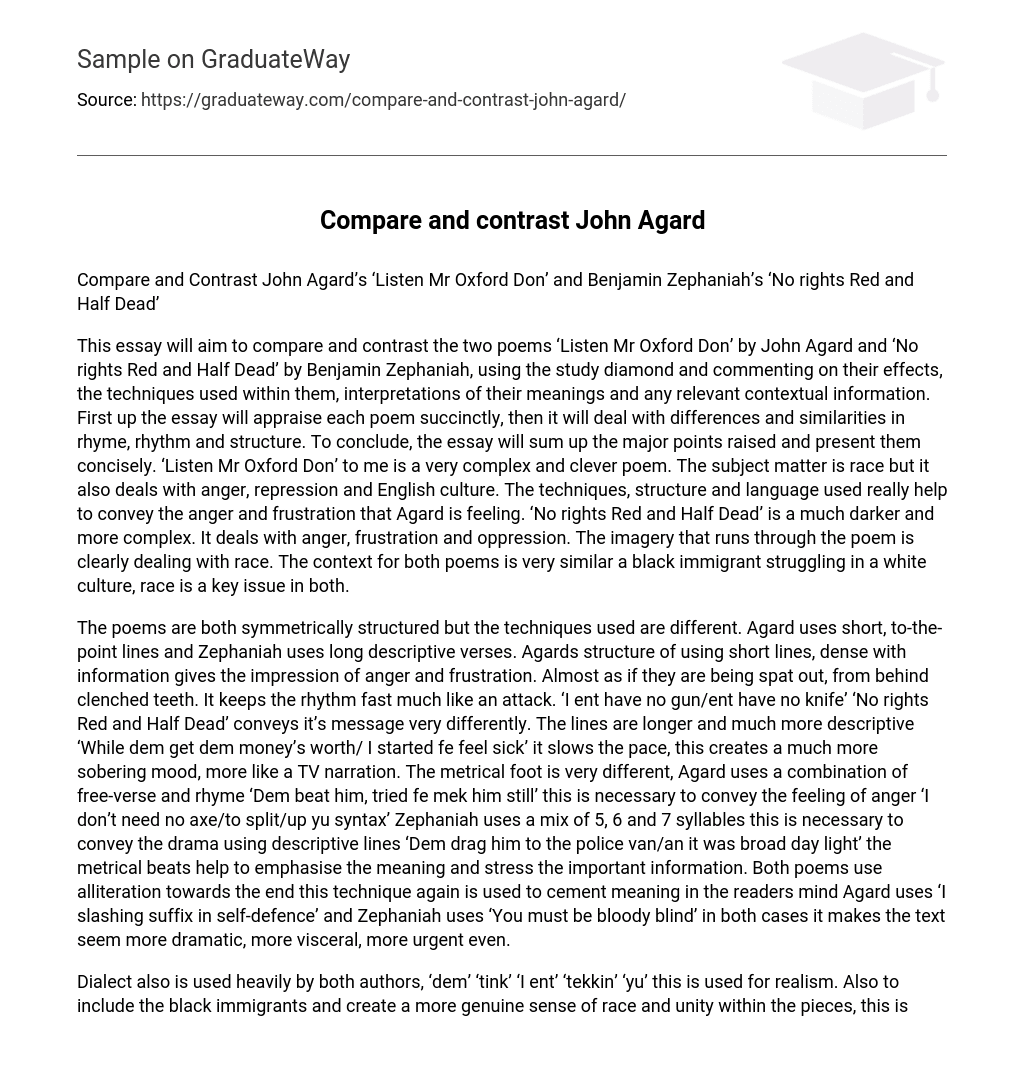Comparing and contrasting John Agard’s ‘Listen Mr Oxford Don’ and Benjamin Zephaniah’s ‘No rights Red and Half Dead’.
The purpose of this essay is to compare and contrast the poems ‘Listen Mr Oxford Don’ by John Agard and ‘No rights Red and Half Dead’ by Benjamin Zephaniah. The study diamond approach will be used to analyze their effects, techniques, interpretations, and contextual information. Firstly, the essay will provide a concise appraisal of each poem. Then, it will explore the differences and similarities in rhyme, rhythm, and structure. In conclusion, the essay will summarize the main points raised in a concise manner. ‘Listen Mr Oxford Don’ is a complex and clever poem that addresses race, anger, repression, and English culture. Agard effectively uses techniques, structure, and language to convey his emotions. On the other hand, ‘No rights Red and Half Dead’ is a darker and more complex poem focusing on anger, frustration, and oppression. The imagery in the poem clearly addresses racial issues. Both poems share a similar context of a black immigrant struggling in a white culture, with race being a significant theme in both.
Both poems have a symmetrical structure, but the techniques employed by Agard and Zephaniah differ. Agard opts for short, straightforward lines while Zephaniah chooses long, descriptive verses. Agard’s use of dense, information-packed lines creates a sense of anger and frustration, almost as if they are forcefully spoken through clenched teeth. This pace maintains a fast rhythm, resembling an attack. For example, “I ent have no gun/ent have no knife” and “No rights Red and Half Dead” convey their messages in a unique manner. On the other hand, Zephaniah’s longer and more descriptive lines, such as “While dem get dem money’s worth/I started fe feel sick,” slow the pace down and create a more solemn atmosphere akin to a TV narration. The metrical foot also varies between the two poets. Agard uses a combination of free-verse and rhyme, such as “Dem beat him, tried fe mek him still,” effectively conveying anger through specific language choices like “I don’t need no axe/to split/up yu syntax.” In contrast, Zephaniah employs a mixture of five, six, and seven syllable lines to add drama and vividness to his descriptive lines, such as “Dem drag him to the police van/an it was broad day light.” The metrical beats serve to emphasize meaning and highlight crucial information. Both poets utilize alliteration towards the end of their respective poems. This technique strengthens the impact of the text on readers, making it more dramatic, visceral, and urgent. For instance, Agard includes the line “I slashing suffix in self-defence,” while Zephaniah employs “You must be bloody blind.” These lines ensure that the meaning is firmly embedded in the reader’s mind.
Both authors heavily use dialect, such as ‘dem’, ‘tink’, ‘I ent’, ‘tekkin’, and ‘yu’, to create a sense of realism and inclusivity. This is vital to the subject matter as it represents the black immigrants and fosters a genuine sense of race and unity in both poems. Rhyme is also employed in both works, although to different effects. Agard utilizes rhyming couplets like ‘axe-syntax’ and ‘grammar-hammer’, which creates a visceral impact when spoken or read, serving to convey anger and frustration. On the other hand, Zephaniah’s rhyme follows a more classically organized rhyme scheme, exemplified by lines such as ‘Yu must be doing fine/ An if yu tink yu seeing justice/yu must be bloody blind’. This structured rhyme helps reinforce the vivid imagery he portrays, allowing for a clearer picture to be painted.
Despite their different rhyme schemes, both poems aim to create more meaning and deliver a direct message. The rhythm in both poems adds to the meaning and sends a powerful message. ‘Listen Mr Oxford Don’ utilizes refrains and short lines to express anger and frustration, such as “Im a man on the run/and a man on the run/is a dangerous one.” Zephaniah’s rhythm operates similarly but without the refrain, with lines like “An it was broad daylight” and “I knew it was not right” and “It was an ugly sight.” The rhythm in both poems is crucial for maintaining the narrative flow and intensifying the words. Agard adopts free verse and unpunctuated line construction to convey the poem’s meaning, expressing his disregard for rules by creating his own and deviating from the norm. The rebellious nature of his writing brings a smile to my face while absorbing the message. On the other hand, Zephaniah requires a more structured and ordinary format to effectively portray the gruesome details he describes, resulting in a powerful and intimidating image that I did not enjoy as much. In conclusion, after analyzing the two poems using the study diamond, it can be determined that they employ similar techniques but with varying intents and effects.
According to Rosemary O’day, Will Hardy, George Marsh, Steve Padley, and Leigh-Anne Perryman-Making sense of the arts (2011), the arts can be interpreted and understood.





